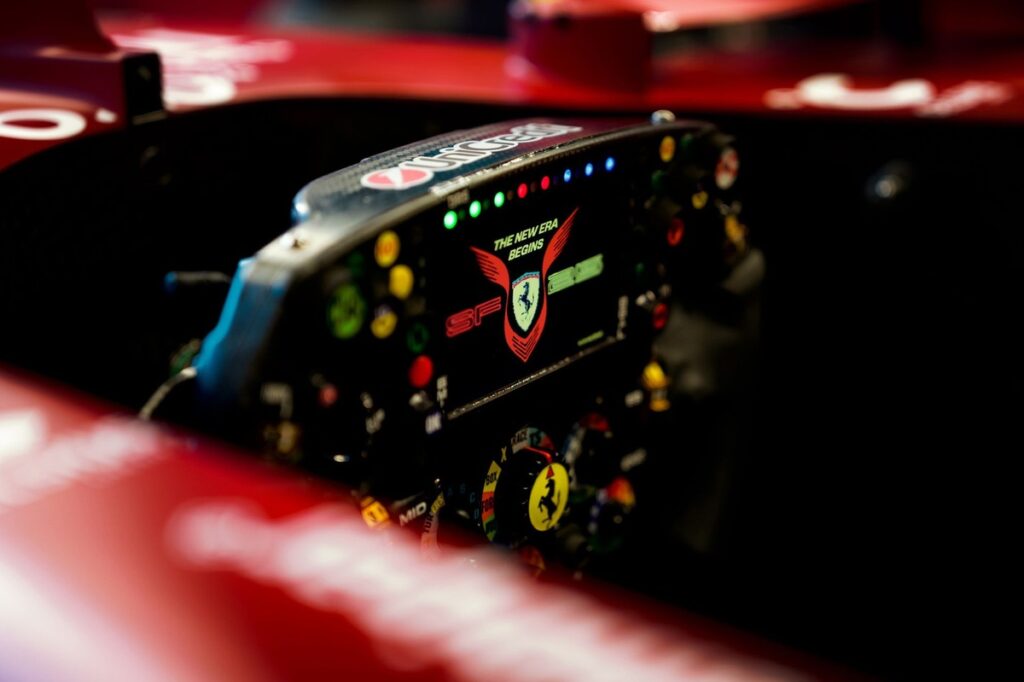The early signs have been positive for Lewis Hamilton. While the team has not been able to execute either race weekend in Australia and China perfectly, Hamilton took his first sprint pole and victory in Shanghai as a welcome boost to his stint with the Italian powerhouse.
Hamilton has spoken at length about how he is still getting up to speed to extract the maximum out of the 2025 car, which is built accordingly to a different philosophy compared to the Silver Arrows. Over 12 years at Mercedes, the seven-time world champion naturally built up a lot of muscle memory in terms of how he likes to drive his F1 cars.
With margins at the front so tight, any minor detail can make a difference. That’s why Ferrari has not been shy of looking at what Hamilton has been used to at Mercedes and implementing it where possible, down to the steering wheel layout he is using.
Lewis Hamilton’s Ferrari steering wheel
Photo by: Gianluca D’Alessandro
Ferrari caught the eye in Australia by adding a personalised welcome message on Hamilton’s steering wheel’s launch screen, but the changes it has made aren’t just cosmetic. There are many things teams can do to customise the steering wheel to a driver’s reference, with Ferrari designing a new clutch and gear lever to provide better ergonomics for Hamilton. The changes don’t stop there either, because at the software level it can also re-programme how much data is provided, a solution that is stepping away from what Charles Leclerc uses and moving much closer to what Hamilton enjoyed at Mercedes.
In addition to the most basic metrics like speed, gear, time and delta, Hamilton’s steering wheel also displays additional information that, on the race screen, is not present for the Monegasque, such as an indication of the engine mappings used. In the upper left area of the screen, he will find an indication labelled ‘SOC’ – the state of the charge of his battery pack, with values from 1 to 12 – and ‘ENG’, which stands for the engine map used.
This choice rests on two reasons. At Mercedes, the management of the power unit was linked to a single ‘STRAT’ knob located at the bottom of the steering wheel. In contrast, Ferrari has used a different management method, with the various elements split up.

Lewis Hamilton’s Ferrari and Mercedes mode race comparison
Photo by: Gianluca D’Alessandro
For example, there are two separate settings for engine (ENG) and hybrid management (SOC). Throughout the hybrid era, all of Ferrari’s drivers have kept the hybrid widget at the top, in the area next to the screen with a selector wheel. However, Hamilton has chosen to move it to the lower part, while ensuring all the selectors at the top replicate the same configuration he had at Mercedes for differential and braking settings.
This is also why, unlike Leclerc, Hamilton has asked for both engine and hybrid mode to be added to the screen, so he is always aware of which configuration is being used, just as he did at the Silver Arrows. There are also additional parameters for keeping an eye on key temperatures.
There are further differences between how Mercedes and Ferrari manage and display their key settings. The Brackley squad amalgamated many functions into just three dials, half the number that can be found on the steering wheel of the SF-25. To choose the selected, which was displayed on screen under the gear, a driver just had to employ the ‘STRAT’ knob in the bottom left-hand corner.
Lewis Hamilton’s Ferrari steering wheel mode formation
Photo by: Gianluca D’Alessandro
In contrast, Ferrari added a quick selector in the centre of the steering wheel to change which modes is being used on the fly, which is then displayed on the screen in the box below the gear. ‘RACE’ is the race mode, ‘BOX’ allows a driver to push before a pitstop, ‘FOR’ is used on the formation lap and ‘PSH’ is used in qualifying. Other options allow drivers to check tyre data and fuel consumption.
One more key difference worth pointing out is found below the window indicating the engine mapping. There is a box dedicated to what Ferrari calls ‘Multi’, i.e. a selector located at the bottom of the steering wheel for secondary settings, which the seven-time world champion also requested to have on his screen.
That management goes into more detail than what he was used to in Mercedes, which is one of the reasons why there is more information on his screen than that of his team-mate, who prefers to have less data to deal with over the course of a lap.
None of those changes necessarily make a big difference to how his car is being run, but if they speed up just how quickly Hamilton feels at home aboard his SF-25, then Ferrari’s efforts will have been worth it.
In this article
Gianluca D’Alessandro
Formula 1
Lewis Hamilton
Ferrari
Be the first to know and subscribe for real-time news email updates on these topics
Subscribe to news alerts
Read the full article here

